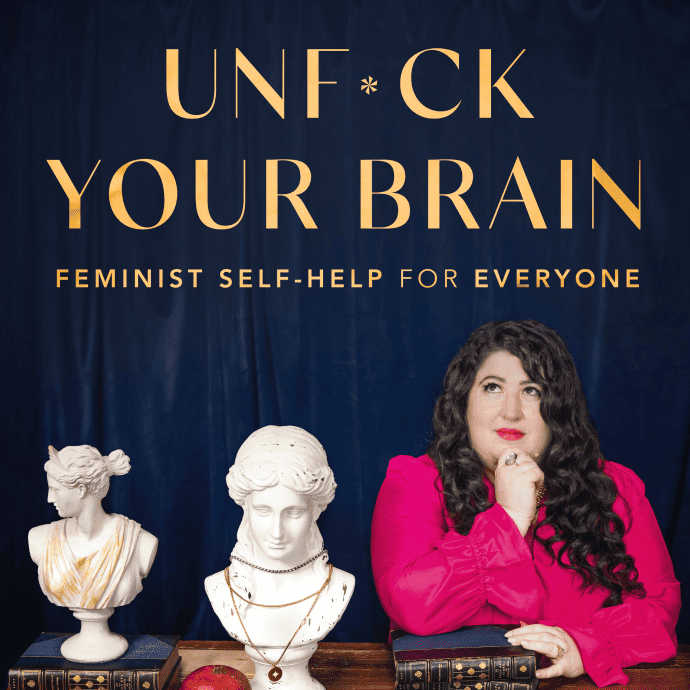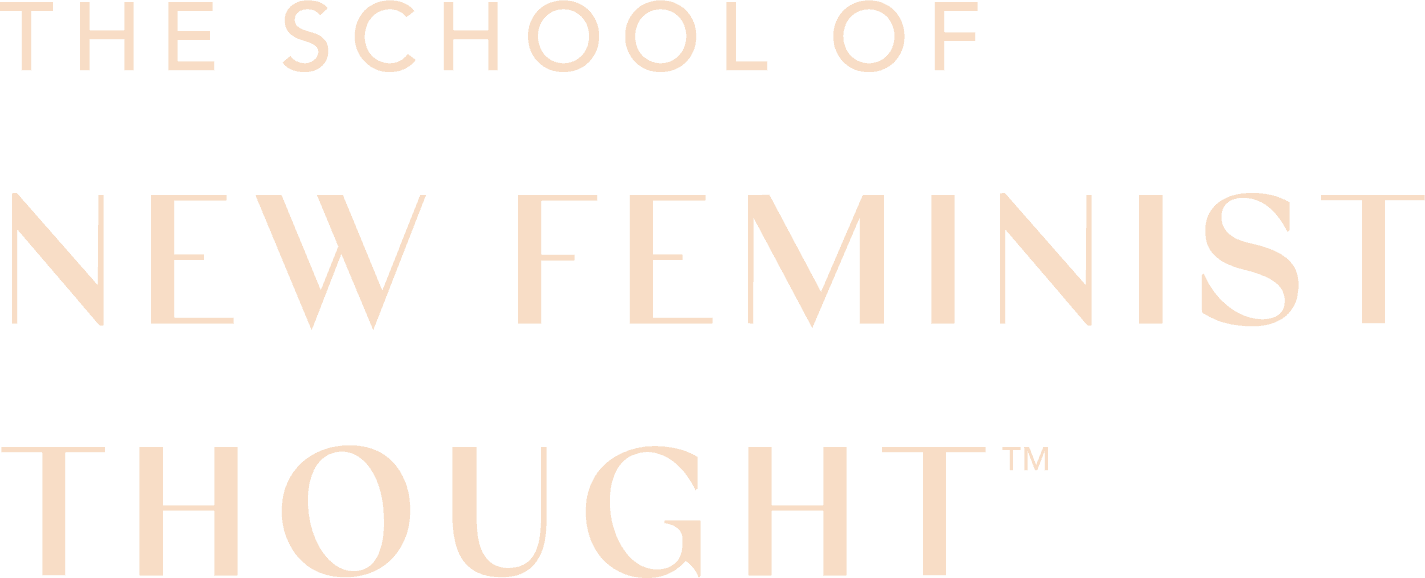
UFYB 321: Choosing A New Year’s Resolution Based On Your Values
What You’ll Learn From This Episode:
- The purpose of a New Year’s resolution.
- How we usually choose a resolution, and why this approach rarely works.
- 3 reasons why we get stuck in a cycle of choosing the same resolution every year.
- A new way to choose and plan a resolution.
Click here to order Take Back Your Brain: How a Sexist Society Gets in Your Head – and How to Get It Out. Get your copy today!
Last week, you heard why New Year’s resolutions tend to get a bad rap, my defence for why they’re actually important, and the purpose they serve in our lives. And this week, as promised, it’s time to figure out how to choose a resolution.
Think about how you would usually set a New Year’s resolution. You probably consider your shortcomings, what you need to do better, or how you want to be better. You might zero-in on where you feel terrible about yourself and then set a resolution to change it. However, this approach rarely works, and I’m showing you why.
If you’re ready to break free from the cycle of choosing the same resolution year after year without making any progress, you’re in the right place. I’m showing you why shame-based resolutions don’t work, and instead, how to set your New Year’s resolution with positive motivation by aligning it with your chosen values.
Featured on the Show:
- Come join us in The Society!
- Click here to order Take Back Your Brain: How a Sexist Society Gets in Your Head – and How to Get It Out
Podcast Transcript:
Hello my chickens, welcome back. We’re doing our second day of our three-part series on resolutions, goals, but specifically New Year’s Eve resolutions and why I love them. I love setting them. I love keeping them. I even love when I fail and I need to try again and why I recommend you do as well. So last week I gave you my defense of resolutions, why I think they get a bad rap, why they’re actually really important and what purpose they serve in our lives.
If you missed last week, go back and listen. It’s super important to understand the purpose of a resolution in general, in order to choose one effectively. The short version is that the purpose of a resolution is to help bridge the gap between the values we have for how we want our lives to actually be. And the familiarity or stagnation that our brains always default to choosing because it’s comfortable and familiar and it is energy conserving to just stay where we are. So again, go listen to the whole episode, but that is the very short summary.
So this week I want to talk about how to actually choose a resolution. The next logical step of what I taught in that last episode is that when it’s time to choose a resolution, we need to use our values to guide that process. And this is not really how we normally try to set resolutions. Normally we think of what we need to do better or how we need to be better and usually that means we’re actually navigating by shame.
So normally what we do unconsciously is we zero in on an area where we feel bad about ourselves and we feel ashamed or guilty or not good enough. And then we set a resolution to try to change that thing so we can feel better. So we’re often trying to change a circumstance or an action we take to force ourselves to think nicer thoughts about ourselves. So, for instance, if we have a lot of self-critical thoughts about our body, we might resolve to lose weight. If we have a lot of self-critical thoughts about our parenting, we might resolve to stop yelling at our kids.
If we have a lot of self-critical thoughts about smoking too much weed, we might resolve to stop doing that. This approach rarely works for a few reasons. It’s also one of the reasons that resolutions get a bad name or a bad rap or seem like something that nobody ever really does, sort of nobody ever really carries through on. Because when we feel shame we’re in a rush to change the behavior and we’re trying to avoid our feelings. And that means we can’t actually get to know the feelings that are driving the behavior.
We aren’t using any strategic insight or understanding to change the behavior, we’re just trying to use willpower. So if you have never gone to the gym consistently and you feel ashamed about that and you feel guilty about not being ‘healthier’ and you decide to set a resolution based on that. If you aren’t actually curious about why you haven’t gone to the gym, then the resolution is basically meaningless. You just say to yourself, I’m going to start doing it and maybe I’ll buy myself some cute workout clothes to motivate me and I’ll put all the gym classes on my calendar.
But you’re not actually paying attention to the thoughts and feelings that have prevented you from doing it, so it’s not going to be successful. When we feel shame about something, we always try to get away from it. We never try to get to know it better. And so we just forge ahead with no understanding, really, of why we’ve had trouble in the past. And then shockingly, we continue to have trouble and this is how people end up in that cycle where they make the same resolution every fucking year and never make any progress with it.
Second, when you already feel shame about something and feel bad about it, especially if it’s been going on for years. You have subconsciously often taken this on as part of your identity. It’s like I’m an emotional eater. I am a bad mom. I am someone who smokes too much. That’s just always how I’ve been, I’ve never been able to quit, whatever it is. When you aren’t looking at your thinking, you won’t ever challenge that identity and you will keep living it out and being that person.
Remember, I taught in the last episode that your brain feels safe when things are consistent even if they suck. So if you think you’re a bad mom and you scream at your kids, your brain feels fine. You may feel unhappy about it, but the part of your brain that is trying to keep you alive is like, great, this all checks out. I am who I think I am. I’m doing the things that I think I do. I’m going to keep doing this. This is safe. This is consistent. There’s no scary change.
Third, when you start with a negative thought and feeling, it’s very hard to create positive and productive change from that place because you don’t actually know where you’re going. You’re not moving towards the person you want to be. You’re just trying to move away from the person you are now who you judge and want to disassociate yourself from. So you don’t really have a positive vision of the person you’re trying to become and positive thoughts about that person. You’re just trying to get away from how you feel now and the self-critical thoughts you have.
So just think about what happens if you get scared and start to run away, if a lion comes into your intersection and you need to run. There’s no great strategy or direction, you’re just going to run fast and try to get away. You don’t know where you’re going. You don’t know how to get there efficiently. You’re not thinking clearly at all. And that’s what happens when you are trying to set a resolution out of shame. Shame based resolutions are a drag and they don’t work, full stop.
So instead, I want to recommend that you set your resolutions based on a positive motivation, which is aligning some area of your life with your chosen values. So here’s what that looks like. First, you need to identify your values. This does not have to be totally encyclopedic. Some people have two or three values that kind of apply to their whole lives. Some people have different values in different areas of their lives. You could also pick one value that you really want to embody in 2024. I mean, a lot of us have just never thought about this explicitly at all.
So to give you an example, some of my overall life values are truth telling, autonomy and pleasure. So I value honesty and transparency and telling the truth. I want to tell people the truth and I want to be told the truth. I value autonomy. I like to be in charge of my own life. I want to direct it. I want to manage my own mind and be in control of what happens to me. Even in intimate relationships, I want to maintain independence and self-direction and I want other people to do the same. And a lot of my life is about helping other people create autonomy.
I value pleasure. I don’t want to just grind out my life. I’m not trying to save all the good stuff for the end. I’m not an aesthetic. I’m not a minimalist. I want beautiful surroundings. I want fresh flowers. I want soft and silky clothes. I want delicious food. I want lots of good sex. I just want a lot of pleasure and beauty in my life. My partner and I always have this back and forth where he says, “Well, honey, we could stay in the motel 8 on vacation and I’d be happy.” And I’m like, “Yeah, I don’t pick the beautiful hotels for you, it’s for me, I want them.”
There’s nothing wrong with staying in a motel 8, if that’s what floats your boat but I want pleasure and beauty around me. That’s a value of mine. And I will spend my time and energy and money to create that. These are very individual. Lots of people don’t value pleasure that much and that’s totally fine. I have the loved ones in my life and probably including my partner who like pretty things or beautiful places, but it’s not an overriding motivation for them.
It’s nice to be independent, but they really value interdependence or they really value family over autonomy or whatever else. This is so individual. So the first step is to identify your values. There are various lists of values you can find online or you can just brainstorm.
Or if you join The Clutch right now, you actually get access to a resolutions mini course that walks you through the process of creating value based resolutions and executing them. So if you do that, there’s a whole exercise on how to choose your values, that’s included in that mini course. And then there’s also an exercise walking you through choosing the resolution and implementing it, all of that.
You can text your email to +1347 934 8861 to get a hold of that, just text your email to +1347 934 8861, no code word or go to unfuckyourbrain.com/clutch. So either way, once you’ve just Googled, or if you’ve joined The Clutch and you’ve done that first exercise, and once you’ve got your values, there are two ways to choose a good resolution for you. And again, we walk through this, if you’ve joined The Clutch or you’re about to join The Clutch, you don’t need to take notes. We have a whole workbook that walks you through this in detail but here’s the big picture for the rest of you.
Once you’ve got your values, there are kind of two ways to choose a good resolution for you. The first is more if you don’t know what resolution to pick yet, you don’t know what you want. So you can look at the list of your values and ask yourself, where in my life am I not living in alignment with these values right now? So if I was doing this, I might look at my life and ask myself, is there any area where I’m not telling myself or other people the truth right now? Am I people pleasing or routinely telling white lies about something? Or is there an area where I’m not telling myself the truth?
Am I in a relationship that isn’t working or is there something about my health that I’m avoiding really dealing with, something like that, I might set a resolution around that. Is there any area where I’m not prioritizing autonomy or where I’m not respecting someone else’s autonomy? Am I trying to control my partner, my friends, my family? I could set a resolution around that. Is there any area where I’m not making enough effort to include and incorporate pleasure? Am I working too much or too hard?
Am I not making time to do things I find pleasurable? Or are there areas where things are unpleasurable for no good reason and I’m not doing anything about it? So that’s where you sort of start with your values and then you look at your life and come up with a resolution that way.
The other way you can do it is if you already have a list of goals or resolutions that you’re really committed to and really want to accomplish. Let’s say you’ve been telling yourself you want to go to Pilates regularly or you want to start practicing the piano again, you really want to have a consistent morning routine. You can take that list and see which, if any, of them are inspired by one of your values.
You might have put, go to Pilates regularly on the list originally because you feel shame about not working out. But if one of your values is strength or aging well or flexibility or something. Now you have a positive value and a positive reason you can connect to that resolution. And that’s going to make the process feel very different. That gives you this positive motivation, this thing you’re moving towards. It’s not just moving towards going to Pilates for its own sake.
It’s moving towards being a person who goes to Pilates regularly because one of my values is strength and flexibility or my value is physical health or my value is aging well or whatever. So it’s very different than just trying to get away from your shame. When you’re just trying to get away from your shame, part of the problem with that is the shame doesn’t disappear overnight and so it’s going to keep coming up. And so you’re going to stop doing the activity because it’s not working, it’s not getting rid of all the shame.
If you feel shame about not working out and you work out for three weeks, then you miss a day or two, you’re going to feel shame again. And then your brain is going to be like, there’s no point in doing this, I still feel shame because you can’t get rid of shame overnight. When you’re moving towards a positive vision of yourself and a value then even if you falter and some shame comes up, it doesn’t matter. That’s not the reason to stop, because the point is that you’re moving towards this positive goal so a little bit of shame on the way is not the end of the world.
If you’re loving what you’re learning on the podcast, you have got to come check out The Feminist Self-Help Society. It’s our newly revamped community and classroom where you get individual help to better apply these concepts to your life along with a library of next level blow your mind coaching tools and concepts that I just can’t fit in a podcast episode. It’s also where you can hang out, get coached and nerd out about all things thought work and feminist mindset with other podcast listeners just like you and me.
It’s my favorite place on Earth and it will change your life, I guarantee it. Come join us at www.unfuckyourbrain.com/society. I can’t wait to see you there.
Pre-Order My Book for Exclusive Bonuses
Take Back Your Brain: How Sexist Thoughts Can Trap You — and How to break Free releases Spring 2024. But when you pre-order now you can get exclusive bonuses including audio lessons and a guided journal to implement what the book teaches. Click here to shop wherever you prefer to buy your books!

